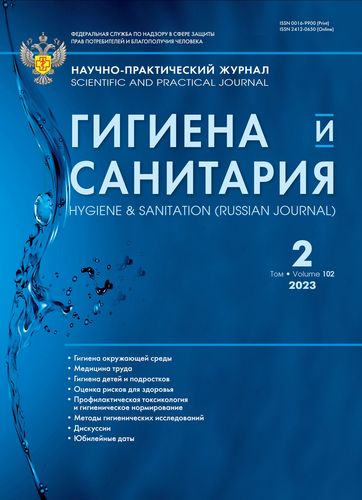On the representativeness of hygienic and sanitary data
- Авторлар: Danilov-Danilyan V.I.1, Rosenthal O.M.1
-
Мекемелер:
- Institute of Water Problems of the Russian Academy of Sciences
- Шығарылым: Том 102, № 2 (2023)
- Беттер: 206-210
- Бөлім: DISCUSSIONS
- ##submission.datePublished##: 25.03.2023
- URL: https://rjsocmed.com/0016-9900/article/view/638621
- DOI: https://doi.org/10.47470/0016-9900-2023-102-2-206-210
- ID: 638621
Дәйексөз келтіру
Толық мәтін
Аннотация
Hygienic and sanitary research, as a rule, are related to the selective control. In this case, the decision on the quantitative characteristics of environmental factors or public health is based on the results of checking one or more selections of samples, and environmental quality is assessed by comparing the values of these characteristics with standards, primarily – maximum allowable concentrations of pollutants. Strict legal regulation of such work is necessary, but the current regulatory documents are incomplete and even contradictory. There are erroneous decisions due to unrepresentativeness, not only to the insufficient amount of initial data, but also to their unsatisfactory processing. The consequence of such decisions is unjustified requirements for enterprises that pollute the environment, charging inflated payments for a negative impact on the environment, etc. Using the example of monitoring for highly variable indicators of the quality of natural and waste waters, showed that in order to make a correct conclusion about the fulfillment or violation of hygienic and sanitary requirements, based on a comparison of several samples, it is necessary to equalize their statistical weights. Violation of this condition can lead to the dependence, oriented in one direction in stratified datasets, will acquire the opposite direction after their summation. In preventing such errors, the role of territorial bodies of sanitary and epidemiological control and supervision is essential.
Compliance with ethical standards: the article does not deal with issues regulated by ethical standards.
Contribution. All co-authors made an equal contribution to the research and preparation of the article for publication.
Acknowledgment. The work was carried out within the framework of the State Assignment of the Institute of Water Problems of the Russian Academy of Sciences (subject FMWZ-2022-0002).
Conflict of interest. The authors declare no conflict of interest.
Received: May 31, 2022 / Accepted: December 8, 2022 / Published: March 25, 2023
Авторлар туралы
Viktor Danilov-Danilyan
Institute of Water Problems of the Russian Academy of Sciences
Хат алмасуға жауапты Автор.
Email: vidd38@yandex.ru
ORCID iD: 0000-0002-5676-3686
MD, PhD, DSci., Corr.-member of the Russian Academy of Sciences, Academic Supervisor, Institute of Water Problems of the Russian Academy of Sciences, Institute of Water Problems of the Russian Academy of Sciences, Moscow, 119333, Russian Federation.
e-mail: vidd38@yandex.ru
РесейOleg Rosenthal
Institute of Water Problems of the Russian Academy of Sciences
Email: noemail@neicon.ru
ORCID iD: 0000-0001-6261-6060
Ресей
Әдебиет тізімі
- WHO. Chemical mixtures in source water and drinking-water. Geneva; 2019. https://apps.who.int/iris/bitstream/10665/255543/1/9789241512374
- Danilov-Danilyan V.I. Water resources of Russia: state, use, protection, management problems. Ekonomika. Nalogi. Pravo. 2019; 12(5): 18–31. https://doi.org/10.26794/1999-849X-2019-12-5-18-31 (in Russian)
- Houck O.A. The regulation of toxic pollutants under the clean water act. Env. Law Rep. News & Analysis. 1991; 21: 10528–60.
- Grigor’ev A.V., Vasen’kina E., Kravets E.A. Regulation of the permissible discharges of pollutants into water bodies established by the federal legislation and feasible directions of its improvement. Vodosnabzhenie i sanitarnaya tekhnika. 2020; (6): 10–5. https://doi.org/10.35776/MNP.2020.06.03
- Zorina I.G., Makarova V.V. Social and hygienic monitoring as the basis of a control in the control and supervisory activities of the Federal Service for Surveillance on Consumer Rights Protection and Human Wellbeing. Gigiena i Sanitaria (Hygiene and Sanitation, Russian journal). 2020; 99(1): 13–9. https://doi.org/10.33029/0016-9900-2020-99-1-13-19 (in Russian)
- Danilov-Danilyan V.I., Rosenthal O.M. Methodology for quantitative assessment of water quality. Doklady Rossiyskoy akademii nauk. Nauki o Zemle. 2022; 502(2): 125–30. https://doi.org/10.31857/S2686739722020049 (in Russian)
- Zaytsev V.M., Liflyandskiy V.G., Marinkin V.I. Applied Medical Statistics [Prikladnaya meditsinskaya statistika]. St. Petersburg: Nauka; 2006. (in Russian)
- Moyzes B.B., Plotnikova I.V., Red’ko L.A. Statistical Methods of Quality Control and Processing of Experimental Data [Statisticheskie metody kontrolya kachestva i obrabotka eksperimental’nykh dannykh]. Moscow: Yurayt; 2019. (in Russian)
- Mozzhukhina N.A., Eremin G.B., Lomtev A.Yu. Contradictions in legislation on medical waste management in the manufacturing of medicinal products. Gigiena i Sanitaria (Hygiene and Sanitation, Russian journal). 2019; 98(1): 38–44. https://doi.org/10.18821/0016-9900-2019-98-1-38-44
- Vanbriesen J., Dzombak D.A., Mellon C. Sustainable urban water supply infrastructure. In: Comprehensive Water Quality and Purification. Elsevier; 2013: 427–49.
- Danilov-Danilyan V.I., Rosenthal O.M. Nonlinear effects in the formation of water quality. Doklady Rossiyskoy akademii nauk. Nauki o Zemle. 2021; 497(2): 189–92. https://doi.org/10.31857/S2686739721040046 (in Russian)
- Narkevich I.A., Zubov N.N., Kuvakin V.I. Statistics in Biomedicine, Pharmacy and Pharmaceuticals [Statistika v biomeditsine, farmatsii i farmatsevtike]. Moscow: KnoRus; 2019. (in Russian)
- Chuang J.S., Rivoire O., Leibler S. Simpson’s paradox in a synthetic microbial system. Science. 2009; 323(5911): 272–5. https://doi.org/10.1126/science.1166739
- Lang T. Common statistical errors even you can find. Part 1: Errors in descriptive statistics and in interpreting probability values. AMWA J. 2003; 18(2): 67–71.
Қосымша файлдар







